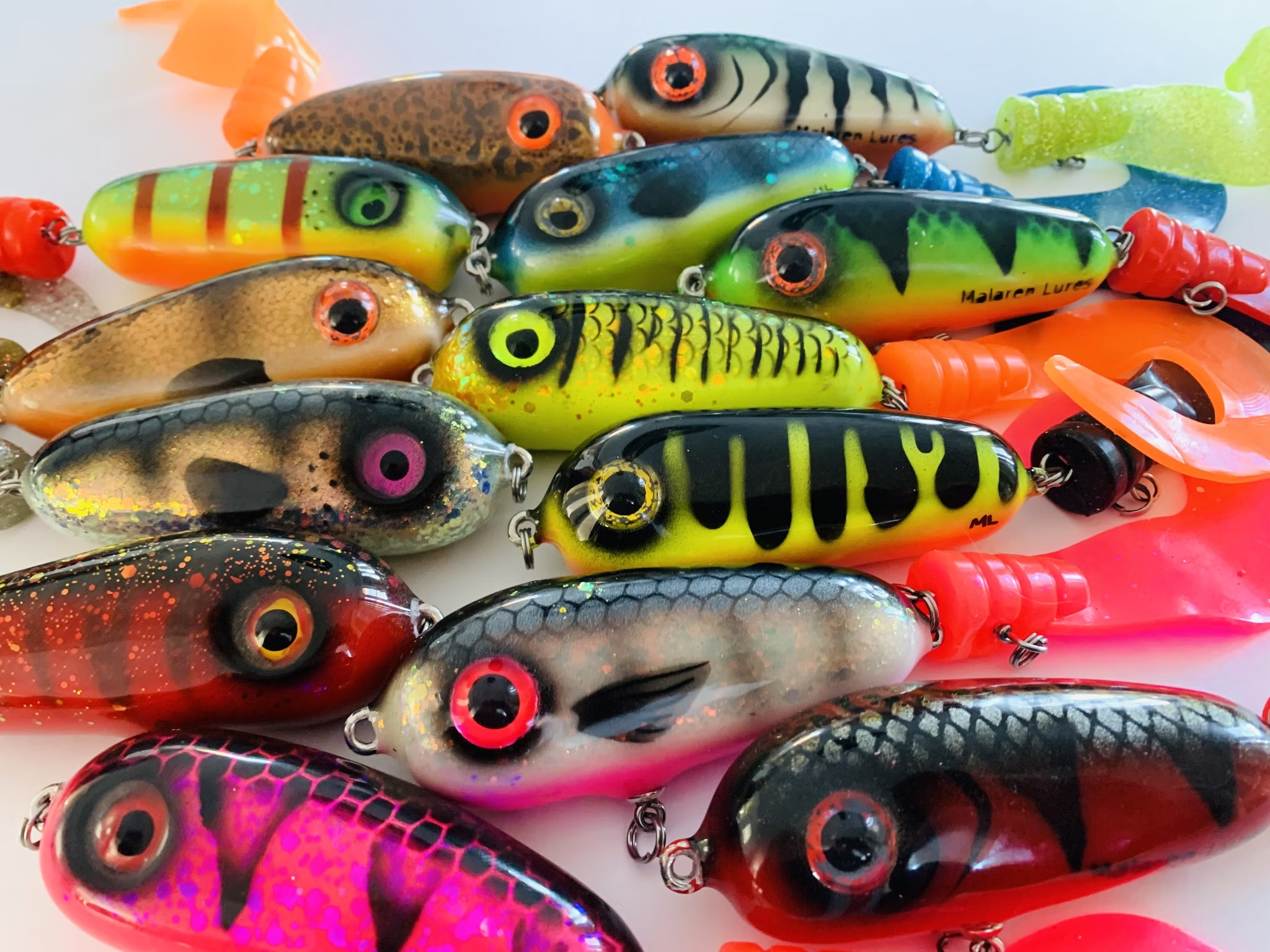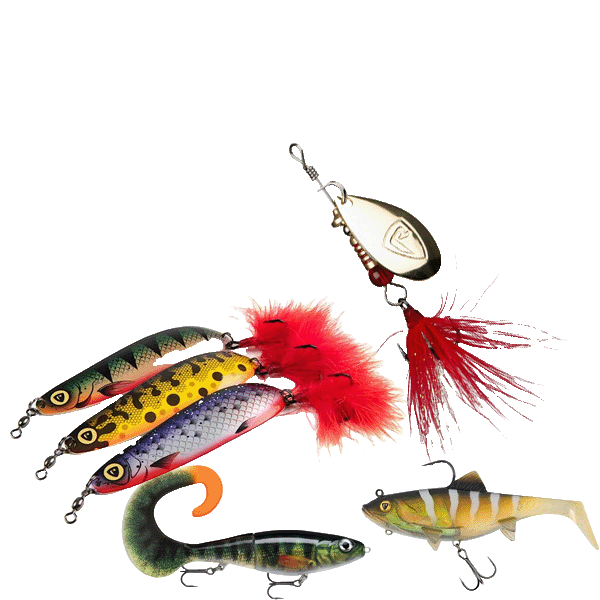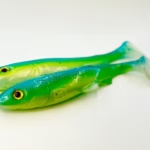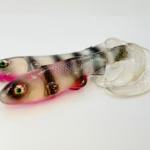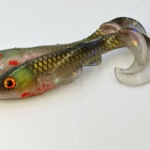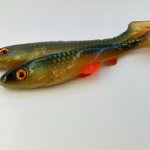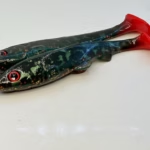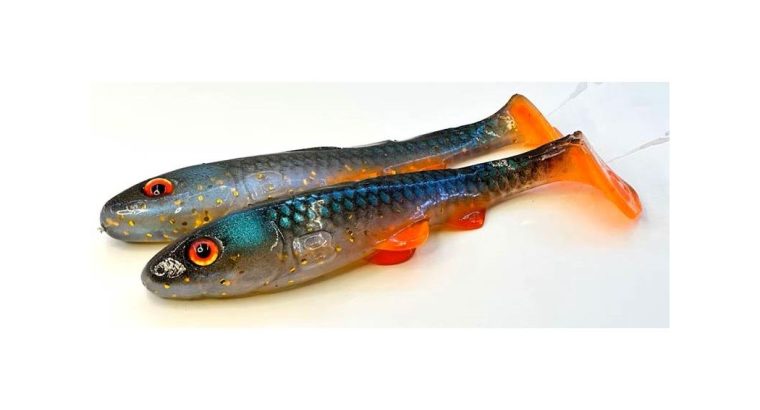
Catch More Irish Pike With BONIbaits Happy Slim 18 cm
You want a soft bait that simply catches pike across Ireland’s mixed venues. Weedy bays one day. Tea-stained rivers the next. Then a bright, clear limestone lough that shows every flaw. The BONIbaits Happy Slim 18 cm is built for that kind of week.
First, the shape works in your favour. The body has a smaller belly and a wide back, so it throws a bold profile without feeling clumsy. That helps pike read it from below, even in coloured water. You also get a clean side-to-side action that stays on track at slow speeds. A steady glide that looks like food. Rigging that plays nicely with a shallow screw and either a single 2/0 treble or two 1/0 trebles on a stinger. So setup is quick, repeatable, and tidy on the bank.
Next, it matches what Irish pike actually eat. Recent Inland Fisheries Ireland research shows pike in many systems now prey mainly on roach, with perch a close second. That means natural roach and perch cues matter when you pick a lure’s silhouette and movement.
In this guide, we’ll review the soft bait, and rigging options that protect the lure’s glide. You’ll get colour picks for peaty loughs, clear limestone, and overcast canals as well as venue tactics you can start using. By the end, you’ll know exactly how to set up, where to throw it, and how to make this shad work for you.
Water, Rules, And What That Means For Your Lure
You fish in a small country with a lot of water. A lot. Ireland holds over 74,000 km of rivers and more than 128,000 hectares of lakes and reservoirs. That’s water in every county, from short urban stretches to big, shallow loughs that sprawl for miles. Your lure needs to switch gears quickly as you move between them.
Now, add the rules. Pike are protected by clear national bylaws. You may take one pike per day, and you must release any pike over 50 cm. You also can’t possess more than 12 coarse fish for bait, and live-baiting is restricted. So, you want clean hook-ups and confident unhooking, because most of your fish go back.
This context shapes your setup choices. Trebles should be sized for secure holds without tearing, and you should carry long-nose pliers, side cutters, and a large unhooking mat. That way, a quick release stays quick, even on a heavy fish. Inland
Water quality varies too, and that affects how you present a lure. Indicator reporting shows river condition is mixed, while lakes fare better overall. On peaty, nutrient-touched rivers, you may need stronger contrast and a slower, steadier track. On clearer lakes, natural silhouettes and tidy glides read more convincingly.
There’s also the economic angle. Recreational angling is not small change here. An IFI-commissioned study valued angling at about €755 million a year, supporting around 10,000 jobs, many in rural towns you visit for pints, diesel, and bait. Your time on the bank matters, and so does reliable tackle that performs across venues.
So, what does this mean for you? You want a lure that copes with variety, respects fish, and saves faff. You’ll be moving from shallow reed-beds to canal shelves to wind-pushed points. Rules say release the bigger pike, so precision matters: solid holds, minimal damage, and fast returns. Meanwhile, different water colours and flows ask for distinct visual cues and speeds. The better your lure adapts, the fewer wasted casts you make.
How HappySlim Fixes Frustrations Every Irish Angler Talks About
“My shad looks wrong in clear water.”
You want a profile that reads like real prey without bulky wobble. The HappySlim 18 cm carries a smaller belly and wide back, so it throws a fuller silhouette that pike can spot from below while still tracking cleanly. That shape also lines up with common Irish preyfish like roach and perch, which makes your lure look “right” at a glance.
“I fish shallow, snaggy bays.”
Hooks and jig heads love cabbage beds. Your lure doesn’t. A shallow screw lets you anchor the nose, keep weight off the head, and cruise above weed tops. The HappySlim is built to “work very good with shallow screw,” so you keep that glide and avoid the salad.
“Pike follow but don’t commit.”
You need a steadier side-to-side that holds near cover on a slow retrieve. This bait’s action is naturally tight, so you can crawl it, add small rod-tip bumps, and make it “hang” beside the stand of reeds instead of surging past it.
“Hook-ups feel random.”
Missed bites usually mean the treble isn’t where the fish are striking. For an 18–22 cm soft bait, a two-treble stinger in 1/0 or 2/0 covers mid-body and tail taps, so you convert more swipes.
“I don’t want to spend hours tinkering.”
Fair. Pick the HappySlim 18 cm (55 g). Screw in a shallow pin. Clip on a two-treble stinger in 1/0 or 2/0. Choose a natural roach-style colour for clear days and a warmer or UV tone for peat-stained water. Then make long, even pulls with pauses beside cover. It’s quick, tidy, and repeatable.
Features Of The BONIbaits Happy Slim 18 cm
Size and weight: The HappySlim 18 cm comes in at 55 g. That’s a sweet spot for Irish pike gear: it casts well on medium-heavy pike rods and fishes comfortably on 50–100 g braid-rated setups. You’re not over-gunned on canals, yet you’ve enough presence for big lough drifts.
Body geometry. The lure carries a smaller belly and a wide back. Underwater, that throws a bold silhouette without excess drag. You get presence in peat-stained water and a believable “baitfish” read in clear lakes. This shape is the whole idea behind the model, not an afterthought.
Action and speed window. The signature is a clean side-to-side that stays stable at slow retrieve. That helps when pike track the lure near reeds or along canal shelves; you can crawl it without the bait rolling out.
Rigging compatibility. Out of the bag, the lure is made for shallow-screw rigging. Couple it with a screw-in nose pin and a compact stinger to keep hooks where pike bite.
Hook spec guidance. The maker recommends either one 2/0 treble or two 1/0 trebles on a stinger for this size. That keeps coverage across the mid-section and tail without over-loading the head.
Finish options. You get a broad colour range suited to Irish conditions, from naturals to UV-charged patterns.
The numbers line up with how you actually fish: castable weight, profile that reads right, action that holds slow, and rigging that keeps things tidy.
Why The BONIbaits Happy Slim 18 cm Body Shape
Triggers Pike
You catch more when a lure looks and moves like food. The HappySlim’s shape does that job with less fuss. The smaller belly and wide back create a bold profile that pike can read from below, yet the lure still cuts through the water cleanly. That means more roll and flash without the clumsy “heave” you get from thicker shads. You see the intent right on the maker’s page: slimmer belly, wider back, and a tidy, side-to-side track.
Silhouette matters too. Pike often key on roach and perch, so a lure that “reads” like these fish wins extra looks. Historic trout-and-perch diets have moved toward roach dominance in many systems. So, a back-heavy outline with a believable lateral line is not cosmetic. It is a direct nod to what pike expect to see.
Hydrodynamics help you slow down. The trimmed belly reduces lift when you crawl the lure along reedlines or canal shelves. In other words, it keeps tracking instead of “blowing out” and rolling. This slow-speed confidence and “rocking walk” matches what you feel on the rod tip. That lets you hold the lure in the bite zone longer—right where lazy followers turn into eaters.
Flash and roll seal the deal. A wider back means more surface to catch light on gentle pulls. On peaty loughs, that extra flash reads like a roach flank turning. On clear limestone, the same profile still looks natural rather than cartoonish. With roach and perch being the most abundant species in many mixed fisheries, presenting that shape consistently stacks the odds in your favour.
Finally, the body plan supports clean rigging. Because the belly is slimmer, stinger hooks sit closer to the body without fouling the action. You keep that even glide while covering mid-body and tail nips. Put simply, the geometry helps your hardware do its job.
Side-To-Side Action, Slow And Controlled
The HappySlim 18 cm holds its line when you slow right down. Its slimmer belly and wide back create a steady side-to-side that stays true even on a crawl. No rollouts. No wobble blow-outs. Just a clean S-path that looks like a roach slipping past cover.
Now to the hang. When you ease the rod through a slow quarter-turn and hold, the lure doesn’t surge away. It settles and hangs beside reeds or cabbage, giving followers a final nudge to commit. That pause is deadly in shallow, weedy bays. You keep the bait in the strike window longer, without adding weight that kills the glide. Pair it with a shallow screw
and you’ll preserve that neutral, level track in skinny water.
The slow-roll is where this bait shines. Start the handle at a walking pace and keep it honest. That body shape keeps the lure tracking when others stall. It matches this feel on the rod: a rocking walk and tail that starts working at low speed. You’ll notice the steady thrum through the blank rather than a heavy thud. That feedback helps you maintain speed without constantly looking at the reel.
Add micro-twitches for flare. A short, 2–3 cm rod-tip pop makes the back flash and the tail kick a fraction wider. It’s a small cue that looks like a baitfish correcting course. Then settle straight back to the slow-roll. If you prefer a playbook, think: count three turns, twitch, one-second hold, then three turns again.
Finally, keep it simple. Shallow screw + stinger and a calm retrieve do more than constant tinkering.
Rigging Tips: Shallow Screws, Stingers, And Clean Hook-Ups
The Shallow Screw Setup
You want the HappySlim 18 cm to glide, not plough. A shallow screw does exactly that. It replaces a heavy jig head with a light, nose-mounted “corkscrew” anchor, so the lure tracks level, rises quicker over cabbage, and holds depth on a slow roll. In plain terms, you keep the natural side-to-side without killing it with lead. If you’re new to screws, this quick primer on rigging soft plastics shows the difference between shallow screws and screw-in jigheads, and when each shines. It’s short, clear, and worth a skim before you rig.
Now the “how”. Take a Pike Shallow Screw (small or medium suits most 16–22 cm shads). Twist the centre pin straight into the nose until the wire eye sits snug. Clip your stinger into the screw’s eye and pin the treble(s) along the belly with spike pins. That’s it. You’ve got a weed-skipping setup that casts clean and swims true.
When to choose a shallow screw
Canals, reedbeds, bays under 2 m, and any venue where weed catches jig heads. A screw keeps the head light and the belly free, so your HappySlim keeps gliding beside cover instead of digging in. And because the lure sits more horizontal, it “hangs” better on micro-pauses.
Stinger Sizes For An 18 cm Soft Bait
Hook size needs to match lure length. Too small and you miss tail taps. Too big and you stiffen the body and spoil the action. For 18–22 cm shads, a two-treble stinger in 1/0 or 2/0 is the safe, proven range.Up to 18 cm can take a single treble; 18–22 cm works best with two trebles, size 1/0–2/0. That aligns perfectly with the BONIbaits Happy Slim 18 cm.
Need ready-to-fish rigs in those sizes? Grab a Pike Rig Shallow with twin 2/0 trebles. It screws in at the nose and pins along the belly in seconds, so you’re fishing rather than faffing.
Two small extras that help:
If fish nip short, slide the rear treble 1 cm further back.
If you’re nicking weed, step the rear treble 5 mm forward to tidy the belly line.
Build Or Buy?
You’ve got both routes. Buy a finished stinger or build one to taste.
Buy pre-made
Look for options with a multi-strand wire, strong split rings, spike pins, and 2/0 trebles. These are usually made for soft lures around 18–25 cm and work nicely with mid-sized shads. Retailers often show full specs — wire rating, swivel strength, and pin placement — so you know exactly what you’re getting.
If you’d rather fine-tune your setup, go modular. Some rigs let you screw in small weights or pair refill weights to tweak your sink rate. That system — screw, weight, and stinger — lets you stay adaptable without committing to heavy jig heads.
Build your own
If you like tinkering, a DIY stinger is simple: 7×7 wire (40–60 lb), size 1/0–2/0 trebles, quality split rings, small swivel, spike pins, and heat-shrink. Keep hook spacing so one treble sits mid-body and one near the tail wrist. For a quick visual tutorial, this short video shows the core steps cleanly.
Hook Placement And Fish Care
Place trebles inline with the lateral line and keep them tight to the belly. That preserves the HappySlim’s glide and stops hooks from acting like a keel. Avoid crowding the head; the front treble should sit just aft of the pectoral area on the moulded body.
Then protect the fish. Carry long-nose pliers, side cutters, and a pike-size unhooking mat. Ireland’s pike rules are clear: one pike per day, no pike over 50 cm, and no more than 12 coarse fish for bait. That means most of your pike go back, so quick, careful unhooking matters.
One last rigging tip. If you’re fishing over 1.5–2 m and want a touch more “hang”, you can add a tiny screw-in weight at the nose or choose a stinger system that accepts clip-on weights. Go sparingly—1–3 g is often enough—so you don’t choke the glide you bought the HappySlim for.
Rig it once, right. Then just fish.
BONIbaits Happy Slim 18 cm Colour Picker
You’ve got a full colour spectrum to play with, from bold reds and UV whites to naturals like Roach, Perch, Gold, and standouts such as Pink Motoroil, Dracula, and Yellow Tiger.
Peaty/Tea-Stained Loughs
Brown water needs contrast and warmth. Peat catchments load rivers and loughs with dissolved organic carbon, which darkens water and eats light quickly. So, you want colours that hold visibility as depth and distance grow. Reach first for Motoroil 2, Gold, and L’Orange. Their warm tones cut the brown well, while a hint of metallic or pearl gives you that vital flicker. Ireland’s peat influence is real and well-documented, with drained peat linked to elevated colour and organic carbon. That’s your signal to favour warm, high-contrast picks on peat-stained venues.
On dull afternoons, swap to Classic Black Red. Dark over dark sounds odd, but it throws a bold silhouette against brown backgrounds. You’re aiming for shape first, then flash. Keep your retrieve steady and slow so the lure’s side profile has time to read.
Clear Limestone Lakes
Clear water punishes anything garish. Natural patterns win. Start with Roach, Transparent Roach, Transparent Perch UV, and Baitfish 2. These sit in the “looks like food” lane, matching the common coarse fish you see across Irish venues.
When light is brutal and visibility high, shift to Golden Perch or Arlee. Both stay natural but add a whisper of flash for long-range pulls over clean weed. Keep leaders thin and hardware neat to avoid spooking fish on bright days.
Overcast Canal Mornings
Low, flat light mutes natural hues, so you need a pattern that “pops” without looking cartoonish. Reach for Pearl White UV and Transparent Id UV. They lift the flank flash at slow speeds and stand out along concrete shelves and reedlines. That UV/pearl boost helps when the sky is a uniform grey and your background is dark water.
If the water’s slightly coloured, try Pale Id or Frans. Both carry a clean base with enough contrast to stay visible under cloud. Keep the retrieve slow with short holds beside lock gates and moored boats.
Weed Edges And Algae Tinge
Green-tinged edges ask for pattern clarity more than shimmer. Pick Hulk Pike and Yellow Tiger. The barred, high-viz patterns break up the outline and stay readable across weed lanes. You’re not trying to shock; you’re trying to separate your lure from the background. If fish track but won’t eat, drop to Shift Bream for a muted, “breamy” tone that still holds shape. Full colour catalogue here.
Sorting Example For Fast Packing
When you’re packing the box, sort colours into four simple buckets and cover each one:
Natural: Roach, Transparent Roach, Baitfish 2, Transparent Perch UV. Use on clear lakes and in bright spells.
Warm: Motoroil 2, Gold, L’Orange, Frans. Use on peat-stained venues and in late light.
High-viz / UV: Pearl White UV, Transparent Id UV, Pale Id. Use under grey skies or at first light.
Dark / Contrast: Classic Black Red, Dracula, Yellow Tiger, Hulk Pike. Use for silhouette and strong contrast.
That four-slot system keeps your decisions quick at the boot of the car. You’ll spend time fishing, not swapping tails. And because these picks are tied to Irish light and water colour, each swap has a clear reason behind it.
Depth Control Without Ruining The Glide
You want hang time, but you also want to reach the fish. Start simple. Rig your HappySlim 18 cm on a shallow screw so it tracks flat and pauses neatly beside cover. A straight, centred screw keeps the lure running true and stops that annoying roll-out at slow speed. The step-by-step primer on soft-plastic rigging shows the key points clearly.
Now add tiny weight only when you must. Two tidy options work without killing the side-to-side:
Integrated stinger weight. This setup includes a small 2.5 g ballast, ideal for 18–22 cm baits. It lets you fine-tune the sink rate while keeping hook coverage just right for tail strikes — handy when wind drifts your line or when you need a quicker drop into 1.5–2 metres.
Screw-in nose weight. A small tungsten screw-in weight at the nose adds just enough fall for short drops, yet keeps the lure level on the pull. Tungsten is compact and sensitive, so you feel the thrum and weed contact better. Go light first: 1–3 g is usually plenty on shallow work.
Place weight with intent. Nose-only weighting gives a gentle “dip-then-glide.” An integrated stinger weight sits lower and can steady the track in chop. Either way, keep it minimal so the body still breathes on the slow roll.
Finally, pair any micro-weighting with clean fish care. Quick unhooking and a ready mat keep you within Irish practice as you fine-tune depth. Skim the handling notes before you head out.
Match The Irish Hatch: Roach, Perch, Hybrids
You catch more when you mirror what pike hunt most. Across many Irish lakes, that means roach first, then perch, with hybrids and bream in the mix. Pike diets in lakes like Conn and Derravaragh have moved towards roach since roach became established. That matters for you, because a roach-like profile and glide now makes strong sense on many venues.
Perch numbers are no sideshow either. Stock surveys regularly log perch as dominant or co-dominant. On Lough Derravaragh (2023), perch made up about 74% of all fish captured during
the survey. That’s a huge signal to lean into perch cues when you’re on that water or anywhere with similar structure and clarity.
You see the same pattern elsewhere. On Lough Meelagh (2023), perch and roach together were ~85% of the survey catch, with roach × bream hybrids also present. When those two species dominate the netting, a perch- or roach-read lure becomes the smart default.
Hybrids deserve a mention. Roach × bream hybrids are widespread and grow well, often showing up in catches from mixed coarse lakes.That “breamy” body shape—deep, rounded, and reflective—explains why muted, bronzy tones with a soft flash can work during calm spells over open weed.
So, how do you apply this with a BONIbaits Happy Slim 18 cm?
Match roach water. Go for a realistic baitfish read and keep the retrieve steady. The HappySlim’s wide back and slimmer belly give you that believable flank and a tidy side-to-side at slow speed, which pike recognise from below.
Lean into perch cues where surveys say “perch-heavy.” Short pauses along weed tops help, as perch prey often holds tight to cover before bolting.
Nod to hybrids on calm flats. Subtle, bream-ish tones and a slow, even pull can be the nudge you need.
Venue-By-Venue Tactics
Big Lough Drifts
Start with long, fan-shaped casts across 2–4 m weed tops. Then run a steady S-glide along the edge, not over the thick stuff. Pike patrol those margins. Drift along the weedline and focus on reeds, drop-offs, and cabbage beds. Keep your lure just brushing the tops for the best results.
Choose colour by sky and clarity. On bright, clear spells, natural baitfish tones look right at range; when clouds roll in, add contrast. If the breeze builds, shorten the cast a touch so you stay connected through the drift. And whatever the weather, wear a PFD on the boat—Irish safety guidance treats it as standard practice.
Canals And Slow Rivers
Canals reward tidy presentation. Fit a shallow screw and a two-treble stinger so the
HappySlim tracks level along the shelf. Crawl it parallel to the bank, then pause beside locks, bridges, and reed pockets. These spots concentrate bait and break the flow. Waterways Ireland lists roach, bream, perch, and pike as canal regulars, so a natural baitfish read makes sense most days.
Bank access is often excellent around towns, which helps you cover water methodically. Spots around Athy and Tullamore hold reliable pike and easy access, so pack a mat, long-nose pliers, and side cutters, and take your time working each feature. Where boats are active, cast after traffic passes—the turbulence can nudge prey off the shelf.
Heavy rain pushes fish tight to fresh edges. So, add a gram or two of weight (nose screw-in or weighted stinger) to drop slightly deeper, then trace the new margin where inflow meets slack water. Timing matters. Check Met Éireann before you drive and watch OPW water-level gauges for rising or falling trends; both shape where pike sit and how fast you should retrieve.
As levels peak, focus on eddies, flooded grass, and creek mouths. As they fall, slide back to the first drop-off outside the flooded zone. Fish care and bank safety come first on wet ground. Keep to permitted access, wear a PFD where there’s depth or current, and give yourself firm footing before casting. National guidance is clear on lifejackets and general angling safety—treat it as non-negotiable. Finally, if you’re hopping between venues, Check, Clean, Dry your gear to avoid spreading invasives along flood-hit systems.
These three keep your plan simple. Drift the weeds on loughs. Crawl the shelves on canals. Read the gauges after rain. Then pick colour and speed to match what’s in front of you—and fish with confidence.
Ethical Pike Care, Unhooking, And Staying Within The Rules
Start with the right kit: a large unhooking mat, long-nose pliers, and side cutters. Keep the fish low on the mat, wet your hands, and keep air time short.
Next, fish within the law. Remember that national bylaws state that you can keep one pike a day, release anything over 50 cm, and limit bait fish to twelve. Avoid live-baiting altogether.
Hook choice matters. Trebles in 1/0–2/0 suit an 18 cm soft bait and give secure holds
without tearing. If you can, crush barbs to speed the release. Support the fish horizontally for a quick photo, then hold it upright in the water until it powers off (see IFI’s handling advice).
Safety counts for you as well. If you’re on a boat or close to deep margins, wear a lifejacket/PFD as standard practice.
Finally, protect waters you love. Check, Clean, Dry your net, mat, and waders so you don’t spread invasive species between venues (guidance and quick steps here).
A Look At BONIbaits
You’re buying from a small Swedish maker with a clear identity. BONIbaits is 100% handcrafted in Sweden and has been pouring soft baits since 2015.
The brand grew on results. Their baits have a track record with big pike across Europe, including fish well over 13 kg. You’ll even find posts citing giants near 130 cm and 18 kg+, landed on HappySlim styles. It’s the kind of proof you want to see before you trust a shad on your home water.
You also get range and consistency. BONIbaits runs families like Happy, HappySlim, and HappyHybrid, with multiple lengths and a deep colour wall, so you can cover peaty loughs, clear limestone, and canals without switching brands.
So with this brand you get handmade Swedish builds, proven big-fish history, and a catalogue that scales from downsized to XL. If you like dealing with a craft brand that shows its work—and its fish—this one is easy to back. Start with the BONIbaits HappySlim 18 cm, then explore the pike hub for the rest.
Buying Smart for your Fishing Expedition
Start with the basics. Pack two or three colours that cover your four roles: a natural, a warm/peat pick, a high-viz/UV, and a dark contrast. That keeps your choices quick at the boot of the car.
Next, sort your hardware. Grab a shallow screw pack so the HappySlim 18 cm runs level over weed. Get simple, nose-in “centre pins” made for shallow work.
Then add a ready stinger for 18–22 cm shads. A two-treble rig in 1/0–2/0 covers mid-body
and tail nips without choking the glide.
Finally, toss in spares. Spike pins, split rings, and one extra stinger save sessions when hooks blunt or weed bends wire.
FAQs About the BONIbaits HappySlim 18 cm
Can I fish it ultra-slow?
Yes. The HappySlim 18 cm keeps a clean side-to-side on a crawl, and it works well with shallow screw, which suits unhurried retrieves in skinny water.
Best stinger size for the bait?
For an 18 cm soft bait, run two trebles in 1/0–2/0 to cover mid-body and tail nips.
Do I need a jig head?
Not for shallow work. Use a shallow screw so the lure tracks level and keeps its glide over weed.
Troubleshooting: Fix The Five Common Mistakes
Too much weight kills the glide
If the bait starts to “nose-down” or lose its S-path, you’ve over-weighted it. Drop to a lighter ball-bearing weight or a smaller screw-in weight so the HappySlim can breathe again. THis is also handy for fine-tuning without a jig head.
Missed hits at the tail
Short nips mean your rear treble sits too far forward. Slide it back ~1 cm and keep it tight to the belly so it won’t foul.
Rolling out on the burn
You’re simply going too fast. The HappySlim is built for a clean, side-to-side at slower speeds. Ease the handle, then add tiny rod-tip bumps beside cover.
Hook rash tearing the belly
Swap to pin-spike stingers so the hooks sit secure without sawing the plastic.
Drop to a single-treble layout or shorten the rear stinger. Then run a true shallow-screw nose to keep the head clear.



